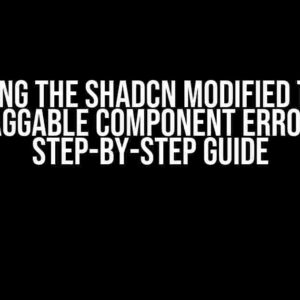Welcome, fellow Vue.js enthusiasts! Today, we’re going to dive into the wonderful world of formatting and explore the mysteries of the format value on v-model. This article will be your comprehensive guide to understanding how to work with format values, so buckle up and let’s get started!
What is v-model?
Before we dive into the world of formatting, let’s quickly recap what v-model is. v-model is a powerful directive in Vue.js that allows you to create two-way data binding between a component’s props and a form input or other interactive elements. It’s a shorthand for updating the component’s state and the DOM simultaneously.
<input v-model="message">In the example above, v-model binds the input value to the component’s `message` property. When the user types something in the input field, the `message` property is updated automatically.
What is the format value on v-model?
Now that we’ve covered the basics of v-model, let’s talk about the format value. The format value is a property that can be passed to v-model to specify how the input value should be formatted before being bound to the component’s state.
<input v-model="date" format="YYYY-MM-DD">In the example above, we’re telling Vue.js to format the input value as a date string in the “YYYY-MM-DD” format before binding it to the `date` property.
Why do we need format values?
Format values are essential in scenarios where you want to enforce a specific format for user input. For instance, if you’re building a date picker component, you want to ensure that the user enters a valid date in a specific format. Without format values, you’d have to write custom logic to parse and validate the input value, which can be error-prone and tedious.
How to use format values with v-model
Using format values with v-model is relatively straightforward. Here are some examples to get you started:
Formatting dates
<input v-model="date" format="YYYY-MM-DD">In this example, we’re telling Vue.js to format the input value as a date string in the “YYYY-MM-DD” format.
Formatting numbers
<input v-model="price" format="0,0.00">In this example, we’re telling Vue.js to format the input value as a number with commas as thousand separators and two decimal places.
Formatting currency
<input v-model="amount" format="USD 0,0.00">In this example, we’re telling Vue.js to format the input value as a currency value with a USD prefix, commas as thousand separators, and two decimal places.
Supported format tokens
Vue.js supports a variety of format tokens that can be used to create complex formats. Here are some of the most commonly used format tokens:
| Token | Description |
|---|---|
| YYYY | Four-digit year |
| MM | Month as a zero-padded two-digit value |
| DD | Day of the month as a zero-padded two-digit value |
| HH | Hour in 24-hour format as a zero-padded two-digit value |
| mm | Minutes as a zero-padded two-digit value |
| ss | Seconds as a zero-padded two-digit value |
| 0,0.00 | Number with commas as thousand separators and two decimal places |
| USD | Currency prefix (e.g., USD, EUR, GBP) |
Common use cases for format values
Format values are useful in a variety of scenarios, including:
- Date and time pickers: Enforce a specific format for date and time inputs.
- Currency inputs: Format currency values with prefixes, commas, and decimal places.
- Number inputs: Format numbers with commas, decimal places, and prefixes.
- Phone number inputs: Enforce a specific format for phone numbers.
- Address inputs: Format addresses with specific delimiters and formatting rules.
Best practices for working with format values
Here are some best practices to keep in mind when working with format values:
- Use format values consistently throughout your application to ensure consistency in user input.
- Use the correct format token for the type of input you’re working with (e.g., date, number, currency).
- Test your format values thoroughly to ensure they’re working as expected.
- Use format values in conjunction with input validation to ensure that user input conforms to the expected format.
- Consider using a library like moment.js to handle complex date and time formatting.
Conclusion
And there you have it, folks! With this comprehensive guide, you should now have a solid understanding of how to work with format values on v-model in Vue.js. Remember to use format values consistently, test them thoroughly, and combine them with input validation to ensure a seamless user experience.
Happy coding, and don’t forget to format those values!
Here are 5 Questions and Answers about “Format value on v-model” in HTML format with a creative voice and tone:
Frequently Asked Questions
Got questions about formatting values on v-model? We’ve got answers!
How do I format a value on v-model?
You can use the `format` option on the `v-model` directive to format the value. For example, `` will format the value as a datepicker.
Can I use multiple formats on the same v-model?
Yes, you can use multiple formats by separating them with commas. For example, `` will format the value as both a currency and a number.
How do I customize the format of a value on v-model?
You can customize the format of a value by using a function as the `format` option. For example, `` will format the value as uppercase.
Can I use v-model with complex data structures?
Yes, you can use v-model with complex data structures, such as objects and arrays. Just make sure to specify the path to the property you want to format. For example, `` will format the value of the `property` property on the `object` object.
Are there any caveats to using format value on v-model?
Yes, there are some caveats to using format value on v-model. For example, if you’re using a function as the `format` option, make sure it’s a pure function and doesn’t have any side effects. Also, be aware that formatting can affect the way the value is displayed, but it doesn’t affect the underlying data.
I hope this helps! Let me know if you need anything else.







